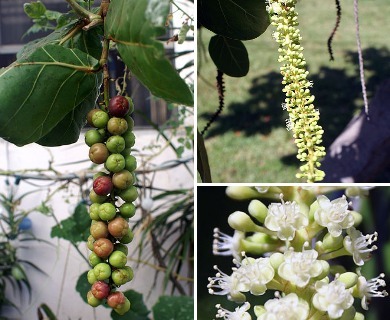Seagrape
Coccoloba uvifera
Smartweed-Buckwheat family (Polygonaceae)
Post-Cook introduction
Seagrape, a small tree planted along sandy beaches as an ornamental or windbreak, is easily identified by the rounded or kidney-shaped thick and leathery leaves, which are slightly broader than long, often reddish when young or very old, and by the drooping grapelike clusters of crowded purple edible about 3⁄4 inch (2 ) long.

©2008 Daniel di Palma
Leaves with short leaf-stalks of 1⁄4–1⁄2 inch (6–13 ) and at base a reddish brown (ocrea) 1⁄4–3⁄8 inch (6–10 ) high around twig. Blades often turned on edge vertically, 3–6 inches (7.5–15 ) long and 4–8 inches (10–20 ) wide, rounded at and heart-shaped at base, with margins slightly curved under, hairless or nearly so, upper surface green or blue green, lower surface paler, and and larger veins often reddish.
Flower clusters (narrow ) and lateral, 4–9 inches (10–23 ) long have numerous small whitish or greenish white fragrant flowers 3⁄16 inch (5 ) across on short stalks of 1⁄16–1⁄8 inch (1.5–3 ), male and female on different trees (). Male flowers have greenish white tube () 1⁄16 inch (1.5 ) long and broad bearing five spreading rounded white more than 1⁄16 inch (1.5 ) long; eight united at base; and rudimentary Female flowers have small and a larger with a one-celled and three
elliptical or egg-shaped, with thin fleshy covering () and with at sour or sweetish, enclosing one elliptical seed () 3⁄8 inch (10 ) long. Flowering and fruiting through the year.
Sapwood is light brown and heartwood reddish brown. Wood hard, moderately heavy ( gr. 0.7), and very susceptible to attack by dry-wood termites. It takes a fine polish but is little used where native except for posts, furniture, and cabinet work. Straight pieces would be suited for wood turning. Because of the similarity of names, it is sometimes confused with cocobolo (Dalbergia retusa), an important commercial timber.
The bark contains tannin, and the astringent roots and bark have been used in medicines elsewhere. West Indian or Jamaican kino, an astringent red sap exuding or extracted from cut bark, formerly was in commerce for tanning and dyeing.
Jelly and a winelike beverage can be prepared from which also are eaten raw. Bunches of in cone-like packets formed by rolling the leaves have been sold on the streets in tropical America, the native home. Early Spanish colonists sometimes used the fresh thick leaves as a substitute for paper, scratching messages with a pin or other sharp point.
This is one of the first woody species to become established on sandy shores where native, being more hardy in these exposed places and more tolerant of salt than most trees. For these reasons it is often planted as an ornamental or windbreak along coasts. Since propagation is from cuttings, female plants should be selected for Frequently grown in southern Florida, it can be shaped as a hedge for landscaping. It is a good honey plant.
In Hawaii, the species is planted as an ornamental and windbreak along sandy beaches, it escapes and becomes naturalized locally. It may be seen along most shorelines. A total of 955 trees have been planted in the forest reserves by the Division of Forestry, mostly in the Honouliuli Forest Reserve. It is doubtful that they became established naturally so far from the shoreline.
Special area
Waimea Arboretum
Range
Shores of central and southern Florida, Bermuda, and from Bahamas through West Indies including Puerto Rico and Virgin Islands. Also, the Atlantic Coast from northern Mexico south to Venezuela and Guianas.
Other common names
uva de playa, uva de mar, uvero (Puerto Rico, Spanish); grape (Virgin Islands)






